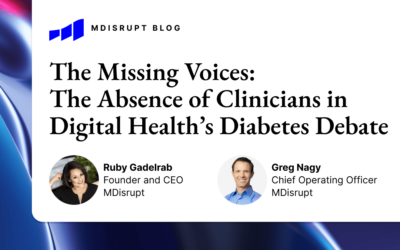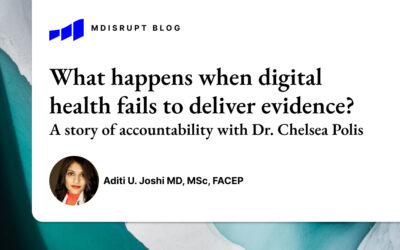
Meet Aditi U. Joshi, MD, MSc, chair of the telehealth committee for the American College of Emergency Physicians and former senior advisor of acute care telehealth at Thomas Jefferson University Hospital.

Dr. Joshi has worked in telehealth for over eight years, most recently leading Thomas Jefferson University Hospital’s on-demand telehealth program. She holds an assistant professorship in the Department of Emergency Medicine at Thomas Jefferson. Dr. Joshi is a champion of health innovation and has a passion for training students and residents about how technology is fundamentally transforming how we interact and care for patients.
An early adopter of telehealth
MDisrupt: How did your passion for health innovation and specifically telehealth evolve?
Aditi Joshi: I graduated residency in 2009 and started my career in a busy emergency department. After a few years, I had symptoms of burnout and decided to try something different. I found an advertisement for Doctor on Demand and decided to apply. This was in 2013 when they were just beginning. I was one of their first doctors and eventually became the assistant medical director. During my time there, I helped develop best-practice protocols to ensure patients were getting a quality visit.
In 2015, Thomas Jefferson University started a huge enterprise-wide telehealth program that piqued my interest. I eventually joined Jefferson in the department of emergency medicine and was the medical director of our telehealth program. My role here has been interesting because, as an academic center, there’s room to try new things. This is also encouraged by our CEO, Dr. Steve Klasko, who has a commitment to health innovation, creating home-based health care, and improving health equity. The team here has expanded and achieved a number of things like a direct-to-consumer program, a triage program in our emergency department, and telehealth education. We also have a telehealth fellowship for post-residency training.
MDisrupt: What is the difference between telehealth and telemedicine?
Aditi Joshi: Telemedicine is the actual service between the patient and the provider. Simply, it’s direct care or a medical encounter. The term telehealth is much broader because it’s not only the services but also includes preventive maintenance, follow-up, and the regulatory portions of telehealth. It’s a more relevant, all-encompassing term. In the future we’re going to realize that telemedicine, or telehealth, is just going to be part of healthcare and the “tele” is going to go away. We may call it virtual care, but eventually, it is just going to be healthcare.
Bringing telehealth to more people
MDisrupt: What are some of the challenges and solutions of adoption in telehealth?
Aditi Joshi: Reimbursement tends to be the biggest reason that clinics and hospitals have shied away from telehealth. It was viewed as an added amount of work without being able to charge for it. With the Emergency Care Act, telehealth got reimbursed to a much broader degree. In respect to that, telehealth visits cost less for both patients and payers. Of course, the caveat is sometimes we need to send patients to a higher level of care because not everything can be done via telehealth. When I first started out, there wasn’t much engagement by either clinicians or patients in telehealth. Patients would pay out of pocket for these types of visits—a limiting factor for many people. As more payers have adopted telemedicine, whether it’s a contract with companies that supply direct-to-consumer telemedicine or a hospital system, it has continued to evolve.
A second challenge is cost. The setup costs to cover technology can be prohibitive for small practices or hospitals that can’t buy the necessary software and hardware. With the realization that telehealth needs to be integrated into the future of healthcare, it’s important to consider the cost to establish these services.
Internet connectivity and access to phones and smart devices is a third major challenge. During the pandemic, there were a number of people in Philadelphia who could not access our platform due to connectivity and technology access. Given the dire emergency situation, my colleagues applied for a grant to do targeted outpatient testing via a mobile van. There’s a second round of grants that focuses on access and expansion of devices and internet connectivity. It’s probably the first time the government has really put that much money into this type of health innovation.
In the future, we’re going to have to figure out how we access rural areas. Today it’s being done with local community interventions such as setting up kiosks or enabling people to access the internet by coming to libraries and community centers.
How innovators can make a difference
MDisrupt: Many in our audience are digital health innovators who have access to capital, technologies, and engineers to build solutions. What could we do better and what are we not doing enough of?
Aditi Joshi: It has been a beautiful thing to see how many people are committed to trying to improve healthcare with all of the digital health solutions that are out there.
When it comes to innovating in healthcare, it can be very complicated, so at the very least you have to understand the healthcare system and how it works.
The biggest complaint from clinicians is that health innovators don’t understand hospital workflows and so they create solutions that make it harder for us to get our jobs done. Physicians are overburdened, so adding something that isn’t useful or efficient or that can’t be reimbursed ends up being a problem. Some ways to get around this are really understanding what your solution is and ensuring that what you’re creating is solving a problem in the first place. I will say that speaking to clinicians early on is a really good idea—with the caveat that we don’t always know the right solution. It’s great to get people who are outside of medicine to innovate, but it’s important to have someone onboard, like a chief medical officer or an advisor, who understands how clinicians practice and how patients respond or use the solution.
MDisrupt: What advice would you give a founder who is interested in telehealth solutions and improving patient care?
Aditi Joshi: First and foremost, understand what you’re trying to solve and get the right team around you—people who work in a similar fashion and have similar goals. I usually give this advice to residents or medical students, but it also works for anybody who is starting a company or has an innovation.
When I started out in telehealth, I really enjoyed it. I kept saying yes to things. I said “yes” to being the assistant medical director, at Doctor on Demand. I said “yes” to Jefferson. And here at Jefferson, every time there was a new program where people came to us and said they want to try this telehealth solution, our department would say “yes” and then we would do it. It didn’t always work! We have a lot of programs we never brought to fruition, but every time we went through the thought process and the workflow it became easier and easier. Now if a health innovator were to ask me, “Can you set up a process to do this type of program?” I would say, “Absolutely!” I can do that because I’ve had practice through trial and error.
Telehealth, ten years out
MDisrupt: What will an interaction with the health system look like in ten years?
Aditi Joshi: I love this question because this is my favorite thing to work on. At the American College of Emergency Physicians, where I’m chair of telehealth, we have a task force looking into how we are going to define emergency medicine for the next five to 10 years because of telehealth.
First, there’s going to be a lot of home-based healthcare for patients with both acute and chronic disease. We’ll be able to use the emergency medical system for acute care and deliver a lot of what we can do in the emergency department at people’s homes. We can also employ more cross-consults which will allow patients to access specialists. We’ll be able to observe patients at home and take better care of them.
There’s also going to be better health literacy once we figure out how to make it palatable. We need to uncomplicate the terms we sometimes use in medicine, so patients can have more control over what they’re doing and what they understand for their health care. The future is going to rely on more individual practice and giving patients the ability to understand and improve their health along with us will be essential.
Medical education is going to change significantly for medical students, residents, and care providers. We’ll also have to continue to understand how smartphones are optimized to work in the healthcare space. They are part of our daily life and we need to make them part of our healthcare, too.
At MDisrupt we believe that the most impactful health products should make it to market quickly. We help make this happen by connecting digital health innovators to the healthcare industry experts and scientists they need to responsibly accelerate product development, commercialization, adoption, and scale.
Our expert consultants span the healthcare continuum and can assist with all stages of health product development: This includes regulatory, clinical studies and evidence generation, payor strategies, commercialization, and channel strategies. If you are building a health product, talk to us.



